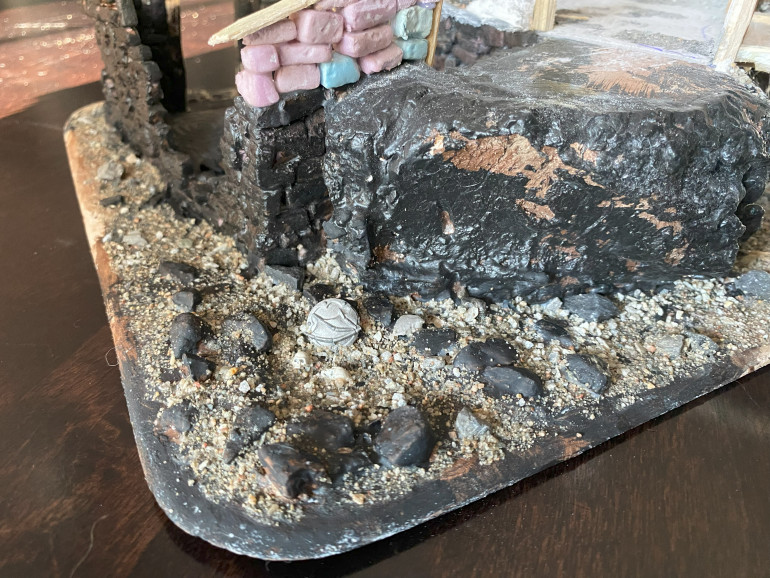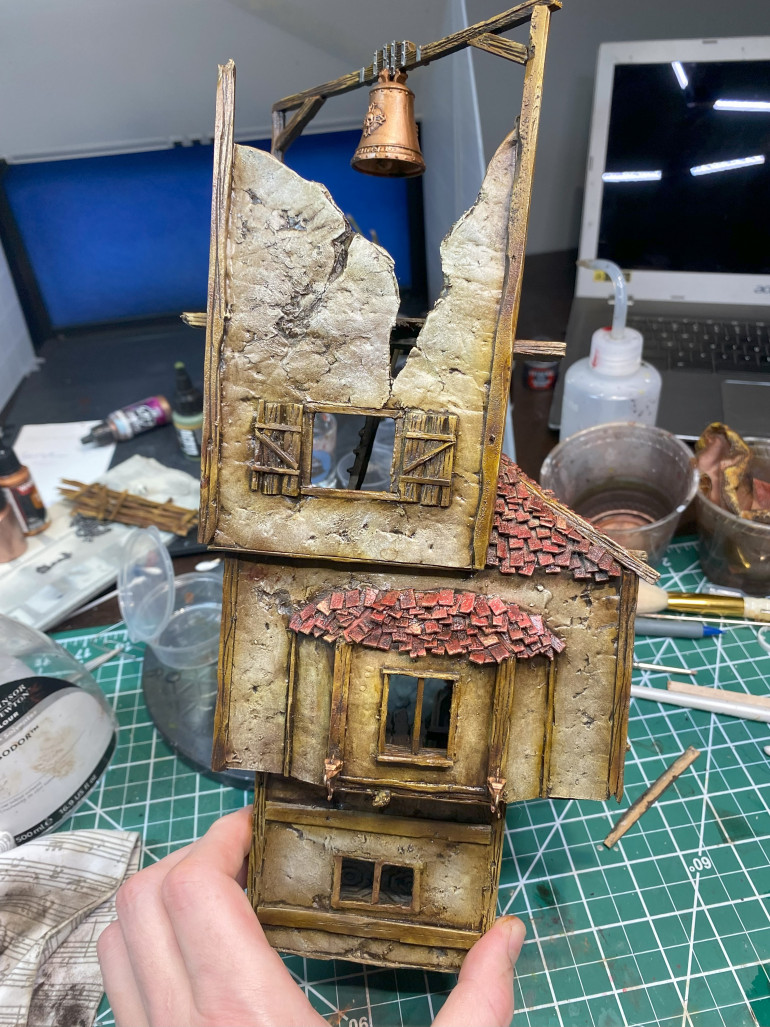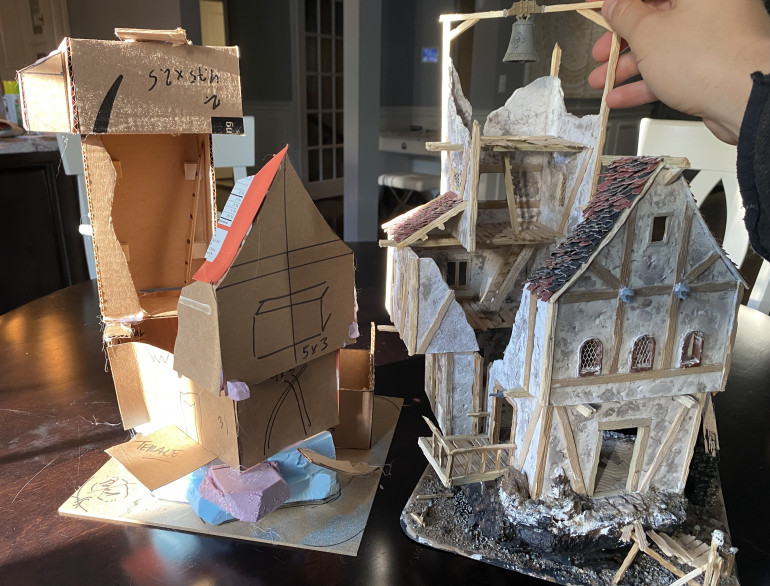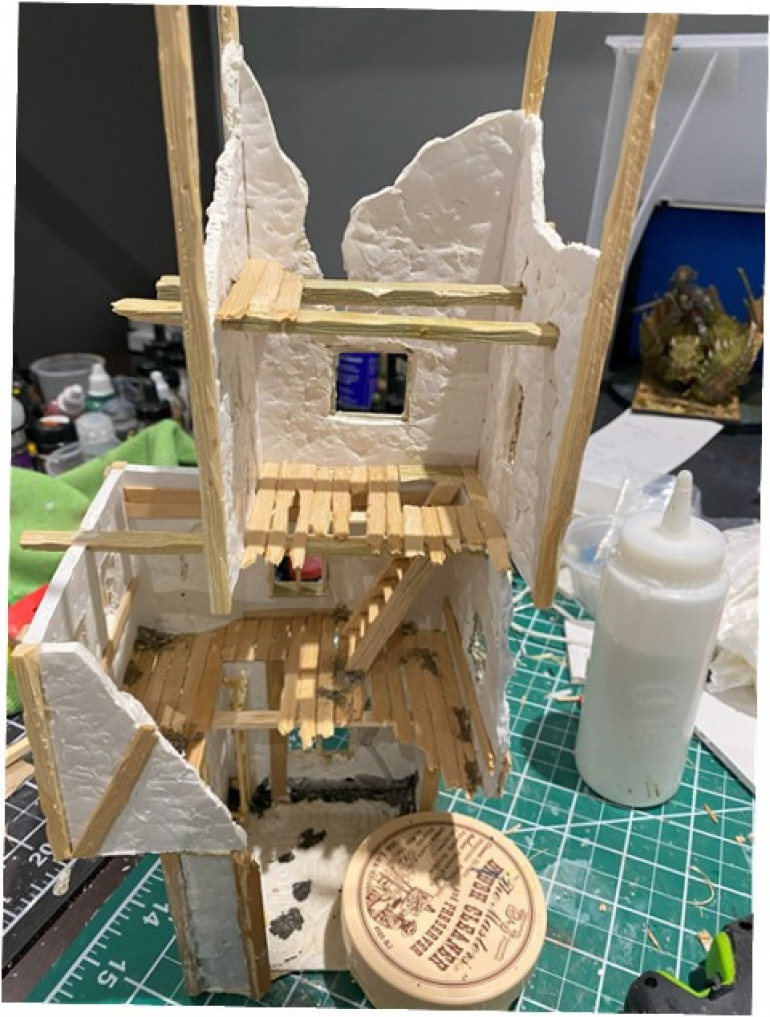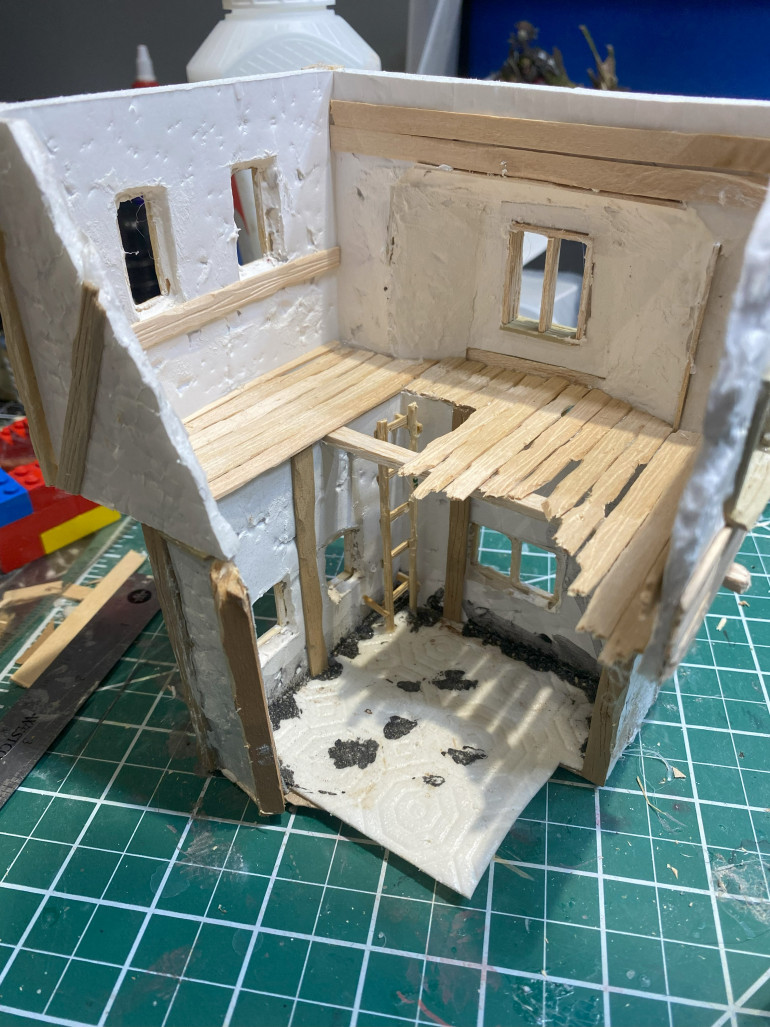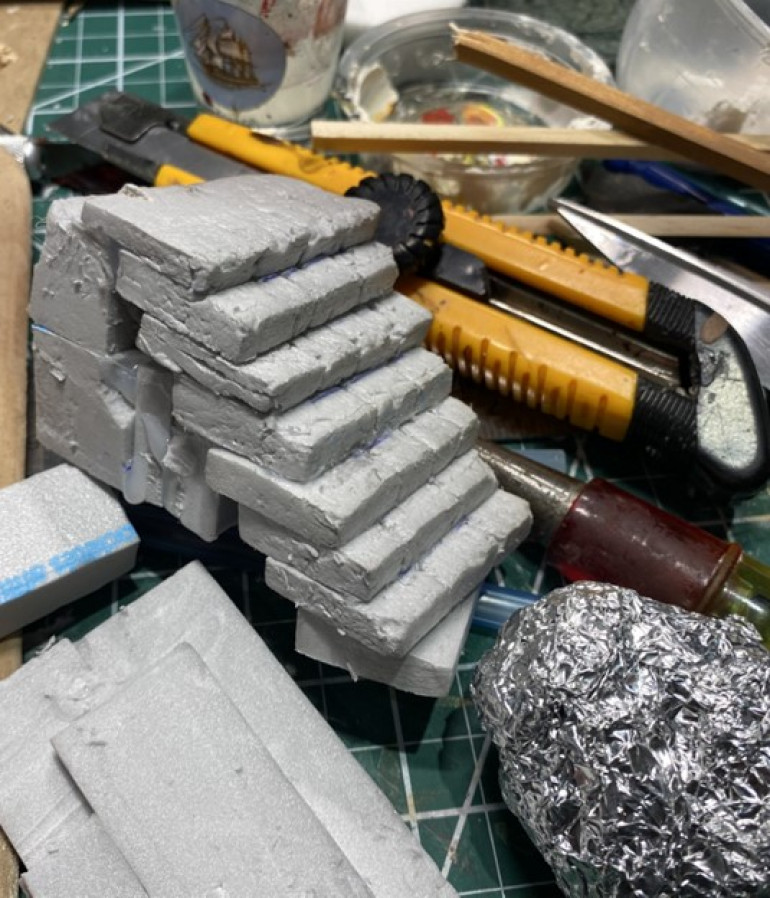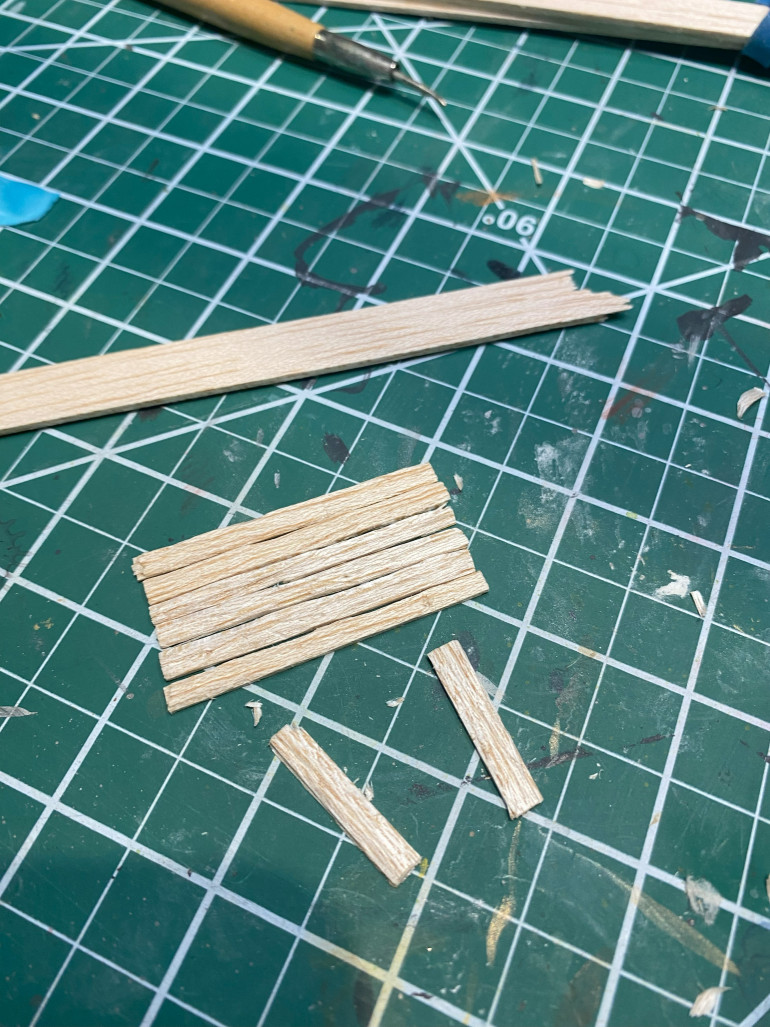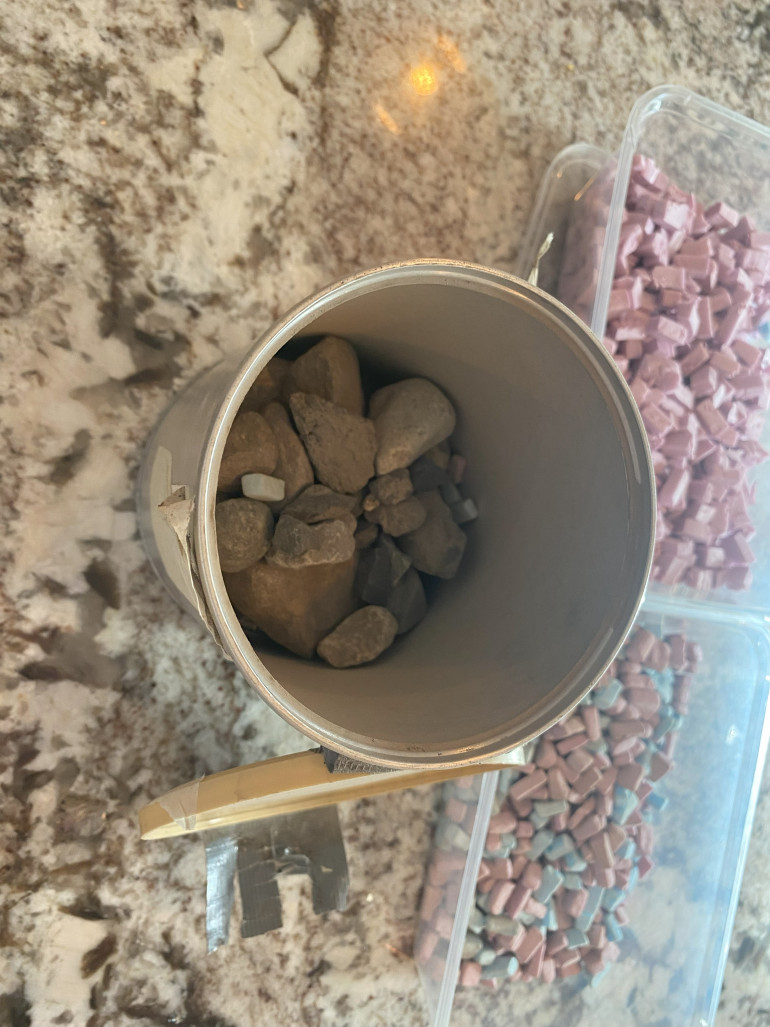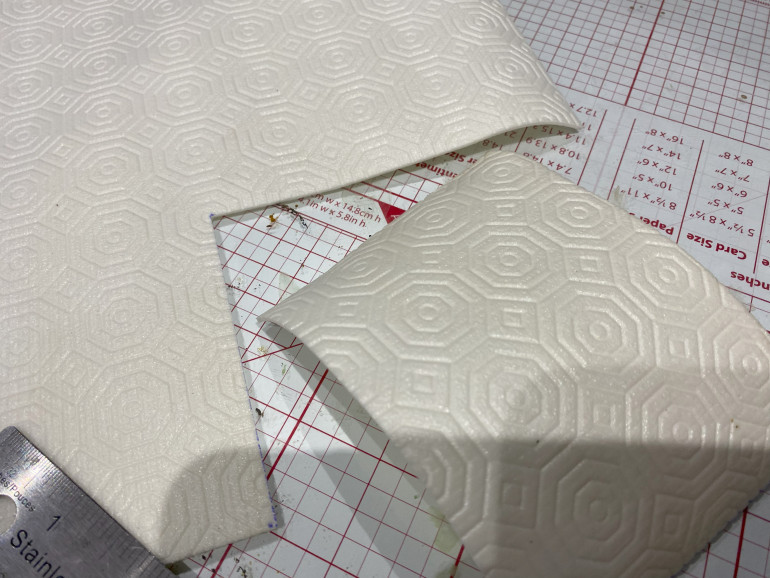
For Whom the Bell Tolls
Recommendations: 404
About the Project
A dark and ancient ruined tower. Going for a grim dark fantasy vibe that would fit right in with Mordheim. As for the title, I do intend to involve a bell at some point.. For crafting, I did not use any fancy or expensive tool (no proxon hot wire cutter) and no 3D printer. Almost everything came from the Dollar store (Poundland in the UK?) or nature (rocks, sands, bark). I did use a few bits from my bits box.
Related Game: Warhammer: The Old World
Related Company: Games Workshop
Related Genre: Fantasy
Related Contest: TerrainFest 2024
This Project is Active
The End (at least for now)
Materials used in this project:
MDF for the base
Foamcore for the walls
XPS foam (insulation foam) for the bricks and the height of the main building
Coffee stir sticks (a lot of them!) and balsa wood
Tile grout and baking soda to texture the walls, shingles, and so on
Bark from the trees in my backyard to make the cliff side
Sand and small rocks from the local playground
Bits and pieces from my bits box for the gargoyles’ heads, skulls and other decorations
Wire mesh from the hobby store to complete the windows
Some Lego pieces for the curved windows (the square/rectangular windows are made from matchstick)
Nothing expensive there 🙂
I couldn’t find a proper bicycle to complete the project (shame on me), but I did got two motorcycles as (poor) substitute. Hope I don’t disappoint anyone 🙂
Dirty water
I initially tried to carved in the MDF base to make a dip for the puddle, but it was not a big success.
I used some cheap clay instead to make surround ground higher (sort of dam effect).
The dirty water effect is simply 5-minute epoxy from the dollar store tinted with a drop of ink.
The water effect looks a bit more transparent and less cloudy in person. My camera skills suck and I think the glossy surface reflects the light too much to show the transparency..
Really happy with the way the rickety/crumbling stairs came out 🙂
The little platform in the middle of the staircase is for playability: any model that does not have enough movement can be placed on that platform.
Basement
Getting close to finishing the painting 🙂
A note on Playability
A key element for added playability is multiple points of entry. I made some interesting ruins before, but sometimes they only had one or two entry points which was limiting from a tactical view.
For this larger building, I made sure there was plenty of ways to enter the building: there are two doors (first floor and the basement), a broken down wooden terrace/balcony where it would be easy to set up a ladder or even a bridge to another building. The last entry point is the collapsed brick wall in the basement.
Another element for playability is to leave enough room for a human hand to reach within and move a model around. My initial prototype had a bigger roof for the basement with longer planks, but it was way too difficult to put your hand inside the building 🤷♂️
Oil wash
Slowly getting this thing painted up.. It’s big and it’s taking a long time!
I used the airbrush for the wood beams and a lot of stippling for the walls.
After the initial basecoat, I apply two thin coasts of satin varnish. It helps to protect the piece and the oil wash will flow nicely over the varnish.
It is not necessary to varnish before applying an oil wash, but since it’s a big piece of scenery and I will manipulate it a lot, I want to reduce chances of having paint stripping off.
I apply a heavy dark brown wash and I removed most of it after an hour or so.
The process went fine, except for the interior. I should have applied a very thinned down oil wash for the interior and not an heavy wash, as removing it with some mineral spirit with Q-tips and small makeup sponges was surprisingly difficult.
Finally completed! (Or halfway done…)
The crafting is complete!
Or halfway done since I need to paint it now 🤔
At least the weather was surprisingly mild for the end of October, so it was perfect for priming the build.
Comparing the final building with the initial prototype 🙂
And unfortunately, the final construction does jot have any bicycle 🤷♂️🤣
And some pictures before the priming with the two parts assembled (the main building and the tower in the back).
Texturing walls.
I love foam core (foam board?) when building ruined houses. Like most materials used in this project, you can buy them at the Dollar store.
It is easy to cut and it assembles well to make walls.
To make it look better, the trick is to texture it. A lot.
Some people like to apply wall splacking/dry wall compound/plaster all over the walls, but my favorite technique involves a sharp heavy rock.
I press (bash) the rock repeatedly against the foamboard with different edges of the rocks to produce a nice worn out texture.
To add even more texture to the walls, I stipple PVA glue over the walls before applying tile grout (the grey stuff you see on the walls). I have used baking soda before for a similar effect on the walls.
I did not tried to cover every surface of the walls.
This stuff gives a nice texture, but it was a real mess in my office.. I would rather do it outside, but I live in Canada and it is getting cold and rainy in October.
Plain flat walls are not very interesting.
These weathering steps don’t take very long, but they add visual interest to wall sections that would otherwise be boring. It will also make the painting process more interesting as the added texture will take up drybrushing/stippling and washing well.
The bell that will sit on top of the tower is from the initial Warcry set. I heavily textured the balsa wood next to it so it would blend in.
Windows
Most of the windows/window frame were scratch-built with wooden matches.
Over the years, I have used different glues when making windows: crazy glue, PVA glue, hot glue gun. Each has its own advantages and problems.
For example, the hot glue gun is faster, but it makes a big blob of glue on a tiny window frame, plus it makes annoying “spider threads” all over the build.
For a few windows, I decided to experiment for the first time with Lego Windows. The main benefit was to get a window with a curve.
To make it fit with the rest of the windows, I textured/carved/ruined the Lego pieces for a more rustic look.
Slowly getting things done..
What whatever reason, the dry wall compound I had was pink, but it turns white when it’s dry 🤷♂️
Wood Beams and Planks (and a lot of coffee stir sticks!!)
Most of the larger beams are balsa wood.
I bought some at a craft store, but I was also lucky enough to find some at the Dollar store!
I did bought all the balsa available at the Dollar store, so I am sorry if you are the unlucky person would came afterwards 🙁
The planks on the walls and the floor are coffee stir sticks.
When bought in bulk, they cost about a penny per stick.
They look better than popsicle sticks.
Some people use a metal wirebrush to texture wood, but I had limited success with that technique.
I use a somehow blunt eyebrow tweezer to indent the wood. (Maybe it came from the Dollar store or my girlfriend’s stash, I honestly can’t remember).
I also found the tip of a somehow blunt scissors was good for indent the wood.
Shingles
The shingles are made out of cheap cardstock.
I covered it with a mixture of mod podge and baking soda for added texture and thickness before cutting it in smaller pieces.
Like the bricks, smaller shingles look better / more realistic, but they take a lot more time to glue.
Stairs and doors and other stuff :)
Like the bricks, the stairs are made up of XPS foam.
I don’t have a Proxxon Hotwire Cutter, so this part was a bit finicky, but I think it came out looking good.
There is no reason for the different colours of XPS foam (grey, blue, rose). I just used any leftovers XPS from other hobby projects or construction projects.
The doors are made up of coffee stir sticks heavily textured.
The only annoying part was gluing some small wires and working a mechanism with the door frame so you can swing the doors open and close.
Clay and Pavement Tiles
The main building is elevated with two layers of XPS foam.
For the rock faces, I used bark from my backyard.
I “baked“ the bark in the oven at 225 Fahrenheit for about 15 minutes to get rid of any organic organism. To be honest, I was a bit worried about the process, but it went fine and I didn’t burn down the kitchen.
The bark was glued with hot glue initially, then a copious amount of watered-down PVA glue was applied.
I used a mixture of wall spackling plus PVA glue to fill in the gap between the bark pieces.
The pavement tiles are made up of simple clay from the Dollar store (again).
Once flattened out, I use actual rocks to add to some texture.
Bricks! (A ton of bricks...)
The bricks are made out of XPS foam (insulation foam).
I cut them to a size of about 5mm x 5mm x 10mm, but I didn’t use a ruler.
I eyeballed the size when batch cutting/crafting them.
I ended up with bricks of varying sizes which is perfect to give a ramshackle appearance to the brick building.
I think smaller bricks look better/more realistic than bigger bricks, but they do take more time to glue.
I used the tried-and-true method of placing the XPS foam bricks in a container with a bunch of jagged rocks, then shaking the can for a few minutes.
It helps to roughen the bricks, give them a bit of texture and it gets rid of the perfect square corner.
I cover the bricks with a mix of black paint + mod podge.
The Base
The base is made up of 12 x 12 inches MDF board from the Dollar Store.
They sell those in packs of 4 planks.
It’s cheap, thick enough (it won’t bend or warp with paint) and it’s easy to cut.
The only downside is the limited size: they don’t sell larger MDF sheets at the Dollar Store, but it is plenty of space for most buildings/ruins.
Bevel the edges and smooth out the corners with an Xacto knife, then I used sandpaper to file.
Sanding with sandpaper (any sandpaper you have laying around) is super fast (like less than two minutes), but the base looks more professional.
The basement floor is a textured shelf & drawer liner that I found (also) at the Dollar Store for two bucks.
First time using it: it has a nice texture to it and it is super easy to cut.
(I imagine it could also be used to make an exterior plaza or courtyard with a fountain or even for dungeon tiles.)
The Prototype
This is a prototype I built last year for Terrain Fest. Unfortunately, life got in the way and I never got around to build the actual thing.
Then I was busy painting two armies for the Old World (Vampire Count and Orcs & Goblins).
The prototype just sat in the closet for a year and now it’s time to do some actual crafting!
I don’t normally build prototype when crafting terrain, but since this piece was bigger with strange angles and different materials, I thought it would be useful.
I did change the architecture a few times, cut a few walls and so on when assembling the prototype.
It’s not a precise plan, it’s more like a rough sketch that will help with sizes and proportions.



















































